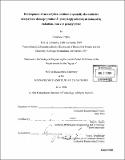| dc.contributor.advisor | Peter Dedon. | en_US |
| dc.contributor.author | Collins, Christiane, 1971- | en_US |
| dc.contributor.other | Massachusetts Institute of Technology. Biological Engineering Division. | en_US |
| dc.date.accessioned | 2005-09-27T16:48:56Z | |
| dc.date.available | 2005-09-27T16:48:56Z | |
| dc.date.copyright | 2004 | en_US |
| dc.date.issued | 2004 | en_US |
| dc.identifier.uri | http://hdl.handle.net/1721.1/28526 | |
| dc.description | Thesis (Ph. D.)--Massachusetts Institute of Technology, Biological Engineering Division, 2004. | en_US |
| dc.description | Includes bibliographical references. | en_US |
| dc.description.abstract | Deoxyribose oxidation in DNA forms strongly electrophilic terminal blocking groups and abasic sites capable of stopping polymerases, forming DNA-protein crosslinks and nucleobase adducts. These threats to the genetic integrity of cells are caused by exogenous and endogenous oxidizing agents and may contribute to diseases such as cancer. To better understand the role of oxidative DNA damage in these diseases, it is necessary to quantify deoxyribose oxidation both in vitro and in vivo. Current methods lack the sensitivity required to measure low concentrations of deoxyribose oxidation products. The goals of the research findings reported here is to develop a sensitive method that can accurately and reproducibly quantify 3'-phosphoglycolaldehyde (PGA), one example of a deoxyribose oxidation product, and to apply the method to quantify PGA in vitro and in cells. Given the presence of reactive carbonyl groups in many deoxyribose oxidation products, the method should be widely applicable to other studies of oxidative ])NA damage. The analytical method exploits the reactive carbonyl moiety in PGA by derivatization as a stable oxime with pentafluorobenzylhydroxylamine, followed by solvent extraction and gas chromatography/negative chemical ionization/mass spectrometry. A stable isotopically-labeled [13C2]-PGA is synthesized and used as an internal standard. The method is linear in response over the range of 30 fmol to 300 pmol and precision is verified by analysis of a synthetic, PGA-containing oligodeoxynucleotide. The limit of detection in the presence of DNA is 30 fmol of PGA. The analytical method was then applied to the quantification of PGA in purified DNA and cultured cells treated with several oxidants. | en_US |
| dc.description.abstract | (cont.) y-Radiation forms PGA in a linear dose response both in vitro and in cells with a 1000-fold quenching effect in vivo. The total quantity of deoxyribose oxidation, determined by plasmid topoisomer analysis, allows the calculation of PGA formation per deoxyribose oxidation event. PGA is formed in 1% of deoxyribose oxidation events induced by y-radiation versus 7% for a-particles. PGA formation induced by Fe(II), Fe(II)/EDTA/H202, and peroxynitrite follows a nonlinear dose response best fitted to a second-order polynomial, in contrast to a linear response induced by Fe(II)/EDTA, with PGA formation representing 5% of deoxyribose oxidation events. Peroxynitrite-induced DNA damage is studied under conditions of both hydroxyl radical and carbonate radical formation. With increasing carbonate radical formation, PGA induction is suppressed which indicates that the carbonate radical is not capable of inducing PGA. | en_US |
| dc.description.statementofresponsibility | by Christine Collins. | en_US |
| dc.format.extent | 190 p. | en_US |
| dc.format.extent | 9259811 bytes | |
| dc.format.extent | 9286016 bytes | |
| dc.format.mimetype | application/pdf | |
| dc.format.mimetype | application/pdf | |
| dc.language.iso | en_US | |
| dc.publisher | Massachusetts Institute of Technology | en_US |
| dc.rights | MIT theses are protected by copyright. They may be viewed, downloaded, or printed from this source but further reproduction or distribution in any format is prohibited without written permission. | en_US |
| dc.rights.uri | http://dspace.mit.edu/handle/1721.1/7582 | |
| dc.subject | Biological Engineering Division. | en_US |
| dc.title | Development of an analytical method to quantify the oxidative deoxyribose damage product 3'-phosphoglycolaldehyde induced by radiation, iron and peroxynitrite | en_US |
| dc.type | Thesis | en_US |
| dc.description.degree | Ph.D. | en_US |
| dc.contributor.department | Massachusetts Institute of Technology. Department of Biological Engineering | |
| dc.identifier.oclc | 57350952 | en_US |
